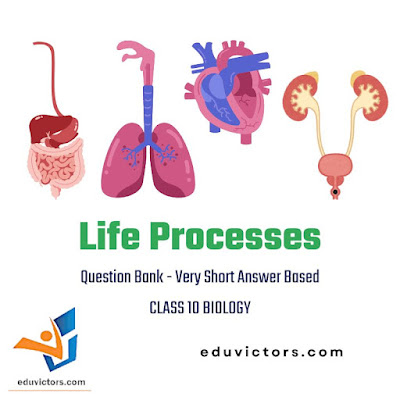Class 10 Biology – Life Processes (Worksheet 1)
Very Short Answer Based Questions
Q1: What is the
common name of the buccal cavity?
Q2: Name the enzyme present in
saliva?
Q3: Which organ releases gastric juice?
Q4: Name
the digestive juice(s) the small intestine receives.
Q5: Name
the largest digestive gland.
Q6: What is the length of the small
intestine in a human adult?
Q7: Which organ contains gustatory receptors?
Q8: What is the pH value of saliva?
Q9: Which organ releases bile juice?
Q10: Does bile juice contain enzymes?
Q11: What is the purpose of the gallbladder?
Q12: What is the main purpose of bile juice?
Q13: Name the enzyme that requires an acidic medium to activate?
Q14: Where does digestion start in the alimentary canal?
Q15: Name the site for complete digestion?
Q16: What does pepsin do?
Q17: Name an organ which is both endocrine and exocrine.
Q18: Name one of the enzyme(s) present in pancreatic juice?
Q19: Between a cow and a tiger, which has a longer small intestine.
Q20: Name the principal organ for absorption in an alimentary canal.
Q21: What is the function unit of absorption of food in the small intestine?
Q22: What does the large intestine absorb?
Q23: Which muscles are responsible for egestion in the alimentary canal?
Q24: Name the final product of digested carbohydrates, proteins and fats.
Q25. Where are chloroplasts present in the leaf?
Q26. Name one organism each having saprophytic parasitic and holozoic nutrition.
Q27. Enlist two functions of the bile juice of the liver.
Q28. Write four factors which affect the process of photosynthesis
Q29. Why/What are molecular movements needed for life?
Q30. What are enzymes?
Q31. Name the enzymes present in saliva, gastric juice and pancreatic juice. Write their functions.
Q32. Which muscle releases the food from the stomach to the small intestine?
Q33. Why do herbivores have longer small intestines and carnivores have short small intestines?
Q34. Write the final products of carbohydrates, proteins and fats.
Q35. What is the role of acid in our stomach?
Q36. How is the small intestine designed to absorb digested food?
Q37. What is the basic requirement of living organisms to obtain energy?
Q38. Name two inorganic substances which are used by autotrophs to make food.
Q39. What is the mode of nutrition in fungi?
Q40. Name the following :
(a) The process in plants converts light energy into chemical energy.
(b) Organisms that cannot prepare their own food.
(c) Organisms that can prepare their own food.
(d) The cell organelle where photosynthesis occurs.
(e) The cells which surround a stomatal pore.
(f) An enzyme secreted by gastric glands in the stomach which acts on proteins.
Q41. How is the wall of the small intestine adapted for performing the function of absorption of food?
Q42. Which one will have a longer small intestine out of a goat and a tiger? Justify your answer.
Q43. State the role of the pancreas in the digestion of food.
Q44. Name a common nutrient that is absorbed in the small intestine and reabsorbed by the kidney tubules.
Q45. What is the role of saliva in the digestion of food?
Q46. What is the role of acid in our stomach?
Q47. Bile juice does not have any digestive enzymes but still plays a significant role in the process of digestion. Justify the statement.
Q48. Name the respiratory pigment in human beings. Where is this pigment found?
Q49. Where does aerobic respiration occur in a cell?
Q50. Name the energy currency in the living organisms. When and where is it produced?
Q51. Veins are thin-walled and have valves. Justify.
Q52. Name the component of blood which transports:
(i) Food, carbon dioxide and nitrogenous wastes
(ii) Oxygen.
Q53. Name the tissues which
(i) transport soluble products of photosynthesis in plants,
(ii) transport water and minerals in a plant.
Q54. Mention the site of exchange of material between the blood and surrounding cells.
Q55. Mention the respiratory unit of the lungs and the excretory unit of the kidneys.
Q56. How is the amount of urine produced regulated?
Q57. Name the pores in a leaf through which the respiratory exchange of gases takes place
Q58. Name (i) largest artery, and (ii) largest vein, in our body
Q59. State the term used for transporting food from leaves to other parts of the plant.
Q60. Name one animal having single circulation of blood and another having double circulation
Q61. What is the other name of ‘high blood pressure’?
Q62. What happens to the glucose which enters the nephron tubule along with the filtrate?
Q63. Why does the heart need valves?
Q64. What is meant by ‘systolic pressure’ and ‘diastolic pressure’? What are their normal values?
Q65. What is the name of the tubes which connect the kidneys to the bladder?
👉SEE ALSO:
Ch 6 - Life Processes (Q & A)
Ch 6 - Life Processes (Nutrition) - Q & A
Ch 6 - Life Processes - Photosynthesis (Q & A)
Ch6 - Life Processes (MCQs)
Ch6 - Life Processes (Gist on Excretory System)
Ch 6 - Digestive Organs & Functions
Ch 6 - Life Processes (Assignment Q & A-1)
Ch 6 -Life Processes: 51 Questions You must Revise

No comments:
Post a Comment
We love to hear your thoughts about this post!
Note: only a member of this blog may post a comment.